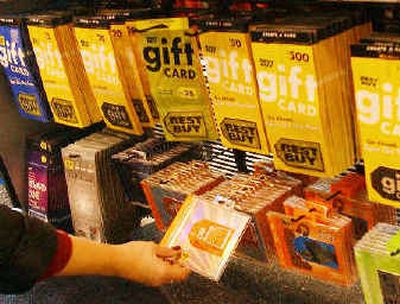For retailers, gift cards are a mixed deck

NEW YORK — The increasing popularity of gift cards is shifting an ever-larger percentage of holiday sales past Christmas into January and even later — and that’s both good and bad news for merchants.
On the plus side, gift cards help stores reduce returns because customers pick out what they want, unlike gift givers who often are guessing what they need. Once in the store, shoppers’ total purchases also typically exceed the value of the cards by as much as 15 percent, according to one industry analyst.
Such benefits, however, are offset by the cards’ potential to “erase substantial amounts of profits from retailers,” according to Todd Slater, director of retail and consumer equity research at Lazard Freres & Co. That’s because the recipient of a $100 gift card, for example, might be able to buy two sweaters on sale after Dec. 25, instead of one before Christmas.
That will put even more pressure on margins in a season where a number of mid- to-low-priced stores like Gap Inc.’s Old Navy chain and Sears, Roebuck and Co. have been discounting even more than a year ago.
Retailers have good reason to be concerned. Gift cards are hotter than ever, with an estimated $17.24 billion worth expected to be sold during the holidays — roughly 8 percent of total sales — according to the National Retail Federation. Some analysts think that the category could account for 11 percent of the holiday business, based on preliminary reports.
American Express Co.’s gift card sales in November increased fivefold from a year ago after the company began selling them at Rite Aid Corp. and in grocery chains like Winn-Dixie Stores Inc.
Chicago-based General Growth Properties Inc., which operates 220 malls in the country, projects that gift card sales should rise 20 to 25 percent this season from a year ago. And Wal-Mart Stores Inc. reported that gift card sales are up significantly this holiday season from a year ago.
All of that means a final accounting of whether the holiday season was a success or disappointment — as it now appears — for retailers is coming later and later each year.
Gift card sales are not booked as revenues until the cards are redeemed. And, with more merchants eliminating fees that erode card values if cards are not used immediately, recipients have little incentive to spend right away.
Greater use of the cards also is forcing retailers to consider stocking less merchandise earlier in the season and increasing the flow of goods in January, Slater said.
Karl Bjornson, a store operations specialist at consulting firm Kurt Salmon Associates, contends the holiday season no longer spans only Thanksgiving to Christmas. “We now have to look at the full month after Christmas to understand the true impact of seasonal sales,” he said.
Customers like James McCusker are a key reason. The New Canaan, Conn., resident said he expects to take his time deciding how to spend his gift cards he’ll be receiving for Christmas.
“With Christmas, I get enough stuff that you don’t need,” he said.
Some stores appear to be getting the message. Federated Department Stores Inc. is expected to increase the flow of fresh spring merchandise to their floors in January, according to analysts.